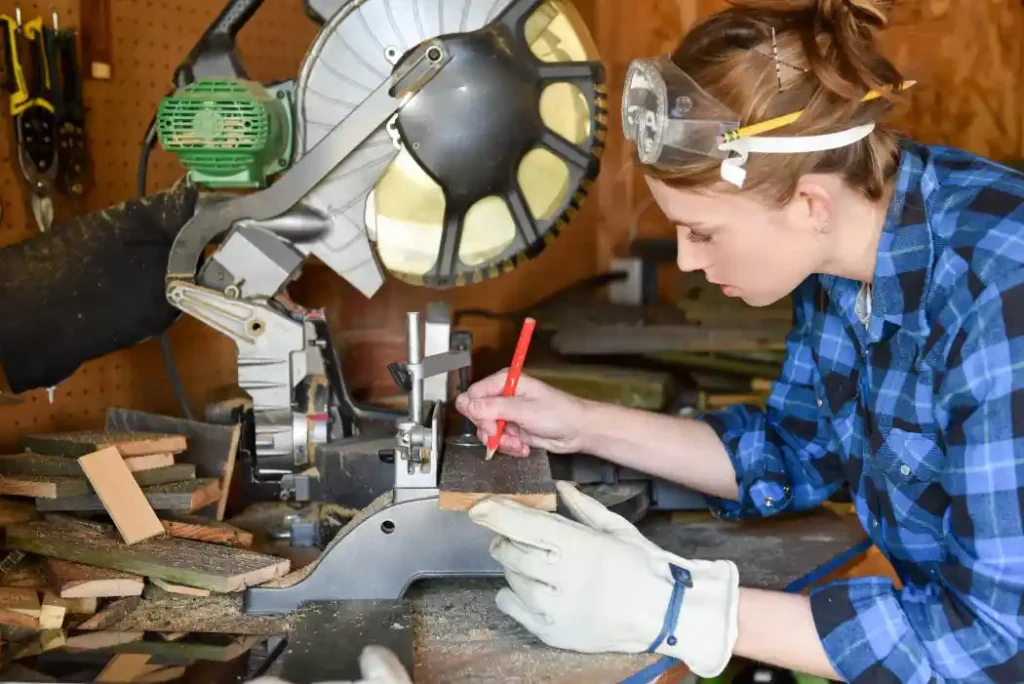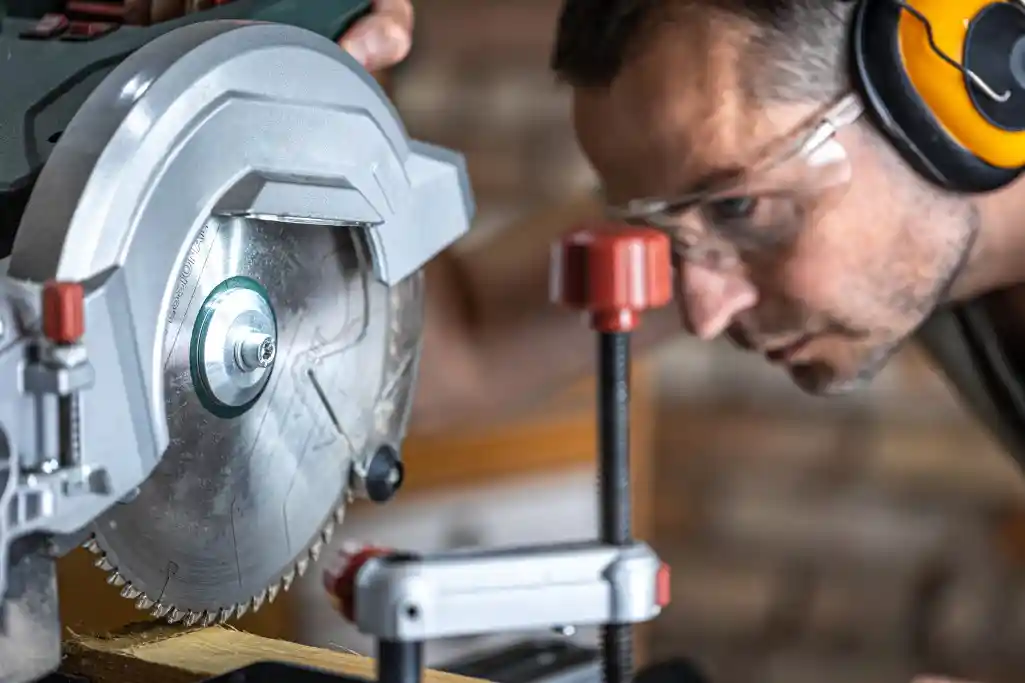If you are planning to buy a saw, deciding between a miter saw and a circular saw can be difficult, even if you know what each tool offers. Remember that while some of the features are identical, there are differences between the two. You should know how each saw tool cuts, what material it is suitable for, what types of blades are available, the price, and how safe it is. Pay attention to your needs as you read this article to make a final decision.
Miter saw
A miter saw is a cutting tool that makes cross-grain cuts in stationary mode. Do not be confused when the miter saw is called a chop saw, as these can be interchangeable. It is referred to as a chop saw since you take the blade down onto the wood in a chopping motion.
A miter saw is for miter cuts, or an angled cut for the corners of a picture frame. It also makes bevel cuts. It does not matter if you have a high-end or low-end; miter saws are worth it. It all depends on what you need. You might buy a low-end saw with a small blade when cutting some trim.
Miter saws make multiple cuts on standard lumber, like 2×4 boards. It also cuts trim, deck planks, and dowels. It cuts long, thin wood. When using a miter saw stop block, you can cut dozens of identical pieces without measuring each. Some miter saws have their stand, or you can purchase one that fits your model. It is comfortable to use on a workbench, but you can also use the floor.

Pros
- Ideal for identical pieces
- Comfortable
- Precise and accurate
- Smooth
- Efficient
Cons
- Not for large pieces
Circular saw
A circular saw is a battery-powered or corded cutting tool that makes rip, bevel, and crosscuts. It is handheld, unlike the miter saw. A circular saw is similar to a table saw, but what separates the two is that you push the saw, and with a table saw, push the material.
All circular saws have the same basic design, a flat plate on the bottom and a blade on the side. There are three main types: miniature circular saws, standard circular saws, and track saws. Due to kickbacks, you are only safe if you use your circular saw responsibly. A good circular saw must make straight cuts.
Failure to educate yourself on how to use the saw, chances are high that you will injure yourself. Kickback can occur when the blade gets stuck between the two halves of the board. There are higher chances that your saw could drop through the cut and injure your foot or leg. If that fails to happen, your fingers might get in the way of the blade. Before you make a decision on which saw to buy, consider these safety considerations.

Pros
- Quick
- Accurate
- Simple
- Portable
- Versatile
Cons
- Kickbacks
Features of a Miter saw
Blade
What determines the size of the board you are going to cut is the size of your miter saw blade. Regarding the miter saw blades, you can have a 71⁄4inch for the occasional DIY-er. However, a smaller saw blade can be limiting.
A ten-inch blade is more versatile since it suits most jobs. This is available at various price points, with the 12-inch blade having the most cutting capacity. It cuts up to 14inch wide, but it is budget-friendly and the heaviest. The saw blade is round and used to make crosscuts and miter cuts in wood, plastic, or metal, depending on the equipped blade.
Fence system
The fence keeps the material straight and in place while the user grips the handle on the saw arm. The other hand holds the trigger down to activate the blade.
Depth of cut
The circular saw has a 7¼inch blade with a maximum cutting depth of 2 ½inches. It becomes difficult to complete a cut through a 4×4 with one pass.
Features of a circular saw
Blades
Circular saw blades can have a high or low tooth count. A lower tooth count is for fast, rough cuts (yorksaw.com). If you want less tear out and splinters at the edge of your board, use a saw blade with a higher tooth count. Circular saw blades come with 24, 60, and even 120 tooth blades. Be sure your saw blade is sharp and has the tooth count for the material you are working with.
The standard blade size for a circular saw is 7¼ inches, but you can use smaller ones. They are easier to handle. These blade sizes are not interchangeable. Always use the correct one for the saw you have. Many woodworkers and DIYers love circular saws because they are incredibly versatile. Unlike miter saws, circular saws are easily portable and can make long rip cuts.
Blade cover
Circular saws cut larger boards down to size. A large sheet of plywood would be difficult to cut with a smaller miter saw. Avoid operating a circular saw without a blade cover for safety. Some people remove blade covers because they take them as an obstruction. All you need is to use it the proper way. Blade covers do not get in the way. They are there to protect your fingers.
Depth of cut
Users can adjust the depth of the cut, and control the shape by directing the saw through the material in the desired shape.
What could be better?
Miter saw
- It would have been better in large pieces. A miter saw is limited by the size of the blade and the size of the cutting table. You cannot use a miter saw to cut through larger pieces of material, like a plywood sheet.
- It would be better for other types of crosscuts.
Circular saw
- It would have been safer to use without kickbacks.
- Circular saws can make the same cut, but the accuracy is up to the user, yet users do not tend to be flawless when using the average miter saw.
Similarities
- Both have large circular saw blades that rotate at high speed and cut through the wood.
- Miter saws and circular saws have disk-shaped, toothed blades that can cut wood, PVC, and even aluminum.
Differences
- A miter saw is stationary, whereas a circular saw is a handheld.
- The miter saw blade is pulled down onto the wood, while a circular saw blade is pushed through the wood.
- A circular saw is ideal for breaking down sheet goods, and a miter saw performs better when cutting down longer boards.
- A miter saw is more precise than a circular saw.
- A circular saw is more affordable than a miter saw.
- A miter saw is safer than a circular saw.
- A circular saw makes both rip cuts and cross cuts, whereas a miter saw only makes cross cuts.
- When using a miter saw stop block, you can cut dozens of identical pieces without measuring each one, but with a circular saw, measure, mark, and line up your blade to cut.
The verdict
Now that you know the difference between a miter saw and a circular saw, you can decide which saw is right for you. Both have advantages and disadvantages, although you may use both for different purposes. If you are not worried about making rounded cuts or working with larger materials, miter saws might be the best choice because they are accurate. For more creative projects, you could opt for a circular saw. This way, you’ll benefit from the flexibility of the tools.
- Grain and Sheen: Teak Oil versus Danish Oil Uncovered - January 10, 2024
- The Cherry on Top: Crafting the Perfect Cutting Board - January 9, 2024
- Polyurethane Water-Based vs Oil-Based: Choosing the Right Finish - January 8, 2024